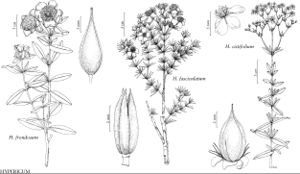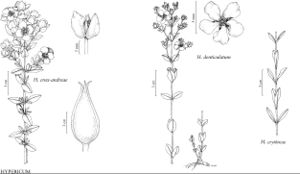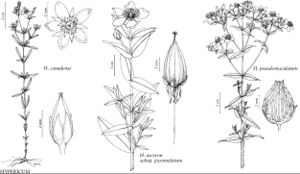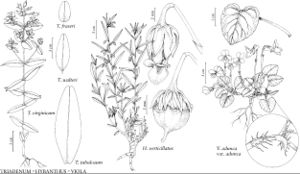Herbs, annual or perennial, subshrubs, or shrubs [trees], glabrous or hairy, hairs simple [stellate to dendroid]. Leaves opposite [alternate or whorled], simple, estipulate, sessile, subsessile, pseudopetiolate, or petiolate; blade with pellucid glands and/or canals containing essential oils, margins entire [rarely gland-fringed], surfaces with black, reddish, or amber glands containing hypericin and pseudohypericin. Inflorescences terminal or axillary, cymose [thyrsoid] or solitary flowers. Flowers homostylous [heterostylous]; sepals persistent or deciduous, (3–) 4–5, glanduliferous like leaves; petals persistent or deciduous, 3–5 [–6], distinct, imbricate or contorted [decussate], orange, pink, or yellow, [white, red], sometimes green or red-tinged, [sometimes with adaxial scale], glanduliferous; stamens persistent or deciduous, in 2 whorls, sometimes in fascicles, sometimes reduced to staminodes; filaments distinct or ± connate; anthers 2-locular, dehiscing longitudinally; ovary superior, 2–5-merous; placentation axile to parietal; ovules 1–2+ on each placenta, anatropous; styles 2–5, distinct or basally [to completely] connate, elongate; stigmas minute or ± expanded. Fruits capsular [baccate], dehiscence septicidal from apex [loculicidal]. Seeds sometimes carinate [winged or carunculate]; endosperm absent; embryo straight [curved]; cotyledons 25–40% of total embryo length.
Distribution
Nearly worldwide except very cold or very dry regions, almost confined to tropics except for Hypericum and Triadenum
Discussion
Genera 9, species 700+ (2 genera, 58 species in the flora).
Hypericaceae flowers are always bisexual, the anther and all or part of the filament remain distinct, the cotyledons are distinct and usually 25–40% of the length of the embryo, and specialization has resulted in heterostyly. In the Calophyllaceae, the anthers and filament are distinct, the cotyledons usually form most of the embryo and may be completely connate, and specialization has resulted in dioecism. In the Clusiaceae, which are also largely dioecious, distinct anthers are often lacking, the stamens having become more or less connate in masses around the ovary, and the cotyledons are minute or absent.
The dark red compounds hypericin and pseudohypericin, naphtho-dianthrone derivatives that are widespread in the Hypericaceae, are contained within black or red gland-dots or -lines in various parts of the plant. These compounds are photosensitizing and lead to eruptions on muzzles of grazing animals. This phenomenon is especially troublesome in dry regions where
alternative fodder may be scarce, for example, California, Iraq, Australia, and South Africa. Hypericum perforatum, which is native in Iraq and introduced in the other three regions, is the main source of trouble. Reports from Ontario indicate that field workers have experienced severe reaction over prolonged exposure to H. perforatum. Hypericum perforatum is also used privately (but not prescribed) as source of an antidepressant; the relevant active ingredients for this treatment are unknown (S. L. Crockett 2003).
Selected References
Illustrations
Key
| 1 | Herbs, subshrubs, or shrubs; petals yellow to orange, sometimes red-tinged; stamens (5–)10–300(–650), in continuous or interrupted ring or in (3–)4–5 fascicles; filaments distinct or basally connate, staminode fascicles 0. | Hypericum |
| 1 | Herbs; petals pink or flesh-colored, sometimes green-tinged; stamens 9, in 3 fascicles; filaments 1/5–1/2+ connate, staminode fascicles 3, alternating with stamen fascicles. | Triadenum |



